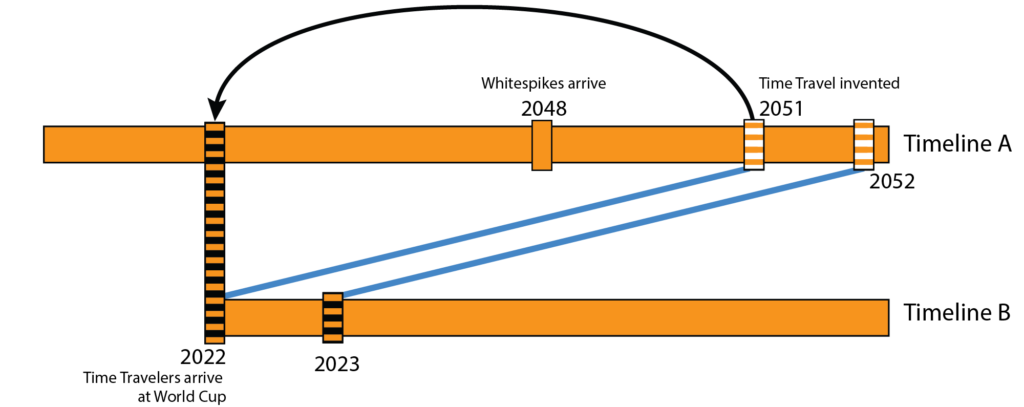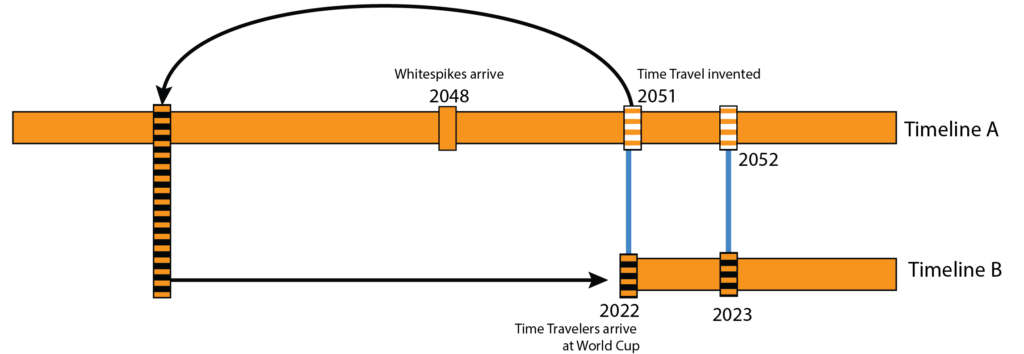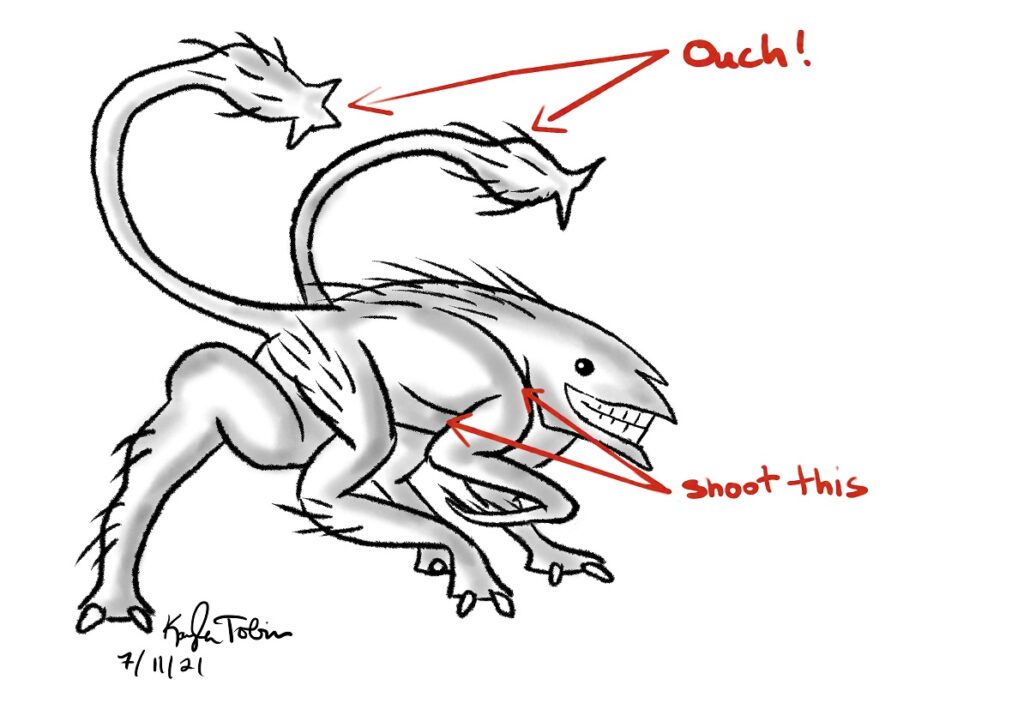Review
The Tomorrow War is a story about a war between humans and an alien race called the Whitespikes. In 2048, the Whitespikes appear essentially out of nowhere and start wiping out humanity. In 2051, they manage to cobble together a time machine (the Jumplink) to 2022. So, naturally, they start recruiting people from the past to help fight the war in the future. We follow family man and ex-Green Beret Dan Forester as he is drafted to fight in the Tomorrow War.
This movie was jolly time travel alien war fun. Great creature effects, solid action setpieces, and a fair number of decent ideas. Also JK Simmons and Sam Richardson are wonderful. Apropos of this blog, the time travel is perfectly consistent, if not particularly complex.
It was not, I’m afraid, a particularly smart movie. The vast majority of that is related to characters doing stupid things, but there were a few times where the laws of physics were avoided as well. I was going to primarily write this post about the chronodynamics of The Tomorrow War, but that’s such a short read I decided to add on some script-doctor sections about where the script went wrong and how it could have been improved.
By its nature, this post is going to be particularly critical of the movie. Nevertheless, I did enjoy it, and it’s streaming free on Amazon Prime. If you have any interest in it at all, you should give it a try.
Chronodynamics
The chronodynamics are pretty straightforward: It is a branching timeline, with a portal linking the two branches. We’ll call the original, prime Timeline A, and the branch Timeline B–so young Muri is on Timeline B and adult Muri is on Timeline A.

The portal’s mouths move forward on both timelines at the same rate, the separation is always going to be 28 years (the link in 2022 started in December, so it’s a little less than the 29 years you’d think based on just the years). So in 2052 on Timeline A, the portal will link to 2023 on Timeline B:

Of course, we are told that humanity won’t last until 2052, so this is just an example.
We could also redraw the diagram so the timelines are synced up vertically:

The portal can be flipped on and off, with varying degrees of success, but it cannot apparently be adjusted.
And that’s all there is to the temporal mechanics of The Tomorrow War! Let’s move on to other things to nitpick. Spoilers ahead!
Better Strategy
We’ll start with the in-universe Watsonian perspective–what the character’s should have done with the situation they were given.
The humans of timeline A are down to a population of about 500,000, meaning 99.5% of the worldwide population has been killed (assuming a population growth to 9.6B by 2048). With their limited resources, they are able to cobble together a janky time machine. It works, but it’s finicky. They manage to find a good point to go back to, the most globally televised event of the year: the World Cup. They explain their situation to the world of Timeline B, and we have our starting point.
So we have two possible objectives: Save Timeline A and save Timeline B. We immediately have two issues: 1) By the time the portal is opened, Timeline A only has 500,000 humans left. Timeline A is already lost. Muri, the highest ranking officer we meet in Timeline A, tells us they already know that A is doomed. Defeating the Whitespikes in Timeline A is effectively not a possibility. 2) Even if we assume that defeating the Whitespikes is possible, Timeline B has no incentive to help Timeline A, certainly not to the tune of thousands of conscripts. So right off the bat, the only viable objective is saving Timeline B.
Now, technically there actually is a way to save Timeline A. Not the Earth, though. The people. Hundreds of thousands of people are sent from Timeline B to Timeline A to fight in the war, so it is logistically possible to evacuate hundreds of thousands from Timeline B to Timeline A. Further, anyone who accepts refugees from Timeline A gains a considerable boon–30 years worth of advanced technical and historical knowledge, experience using future technology, and lest we forget, the knowledge necessary to prepare for the war.
Ignoring all that, Timeline B opts to try and save the Earth in Timeline A. As far as we are aware, there’s no transfer of information, ideas, technology, or materials; Timeline B just sends human fodder to Timeline A. We know this because apparently no one had previously analyzed any Whitespike materials to find their point of origin until Dan talked to a high school student. So that really should have been the first thing anyone did.
We will give them the benefit of the doubt and assume that, to the best of their knowledge, they needed the toxin to ensure that any timeline survives. After all, if they fail to locate the Whitespike point of origin in Timeline B, they will need some superweapon to fend them off. In that case we justify having to send natives of Timeline B to Timeline A, in order to gather information and resources. But this just reinforces the need for information transfer between A and B. It also requires a massive shift in the tactics employed.
Speaking of which…
Better Tactics
Once we assume that there’s no victory in conventional warfare, it requires a paradigm shift in tactics. Just in general, the tactics employed seem to be of a “throw as many bodies at the problem as possible” bent. The missions should have all been aimed at the only known solution–the female toxin. We know they weren’t, because if they were then someone would have told the draftees in Timeline B.
When it came to training, the objective seemed to be to get as many people killed as possible. Training was rushed, supplies were limited, draftees weren’t even told what they were up against, and criteria for selecting draftees were nonsensical.
Starting with that last one: For some reason, people are only drafted if they’re already dead in Timeline A (which almost everyone should be, because there’s only 500,000 people left), while only young people are sent to Timeline B to man the outpost. I believe we’re supposed to assume a paradox will occur if they don’t do this, but that is a somewhat ridiculous idea in a branching timeline. No real reason is given, but we might guess that they are using it for moral justification, i.e., “they’re going to die soon anyway, so it’s ok if we send them to die in the future war.” As for why only young people were sent back, perhaps it was just in case things go sideways and they’re cut off, so they can live a long full life?
On to the actual training. There’s no point in keeping the aliens’ morphology a secret. The people were already drafted, so all they’re doing is increasing the chance of panic because they’re not prepared for what they see. You can maintain the creepiness of the reveal if you just use drawings to show them, like this:

We aren’t privy to the majority of interuniversal missions, so we have to base our analysis off the one we do see, and the first mission we see is fraught with tactical blunders. The intent was to retrieve specimens and personnel from the most important R&D installation in the world. Inasmuch as the war was winnable, it hinged on the success of this mission. And they decided to send in a bunch of rookies with barely a day’s training in. Further, they intended to firebomb the area, despite it already being lost and devoid of human life, and despite it containing vital materials. The firebombing served no tactical purpose except to help the Whitespikes.
And now that I think of it, what was that lab doing in Chicago? They seemed to have a fully functioning lab in the fortified atoll, so why leave one in the middle of a ruined city?
As for prep, let’s talk about firearms. The popguns they give the conscripts are near worthless. They only deal damage when fired at the neck or underbelly–not an easy feat for people with 1 week of training and who are completely unprepared to face such a monster. They needed higher-power armaments–armor-piercing, or explosive-tipped, or something. We see later that a mounted .50 caliber can mow through them, so it is possible for conventional arms to work. Heavier weaponry might be a nuisance to carry around, but it’s better than carrying around the BB guns they had.
Speaking of the .50, vehicular combat is where humans should have the clear advantage. While a humvee is easily capsized by a Whitespike, a tank or an APC should fare better. Whitespikes’ projectiles embed themselves in the human body, which means they are not going to be strong enough to pierce a tank. Further, humans have total air superiority. Whitespikes can glide like flying squirrels, but they have no clear way to effectively fend off aircraft. At a high enough elevation, even a stationary aircraft would be impossible to hit for Whitespikes; a dirigible would be an effective attack vehicle.
Better Screenplay
Not to kick a movie while it’s down, but I might as well talk about some of the kinks in the screenplay that could make the overall narrative flow better–the Doylist perspective.
Dan’s character arc needs to be better fleshed out. We get the first seed of discontent when he’s denied a job offer, and he’s mad his dad ran away. Cut to: he leaves his wife then dies in a car accident. He’s never given any clear flaw or character trajectory. Being ambitious isn’t a big enough character flaw that it clearly leads to abandoning your family, and certainly not big enough that he needs redemption for it. And if it’s supposed to be a character flaw, he shouldn’t solve it by actually saving the world; that just validates the flaw!
The toxin ended up being a big shaggy dog story. We spend half the movie developing this toxin that’s supposed to end the war (and Dan apparently attempts to sabotage it by diving into a sea of Whitespikes, though he is counter-sabotaged by being recalled to Timeline B), and the toxin ends up being irrelevant. It’s not used in Timeline A, because Timeline A is lost, and in Timeline B it’s less effective than just using C4. In fact, the toxin actually almost messes everything up in Timeline B–by administering it poorly, they wake up the Whitespikes and almost release them into the world; if they had blown up the ship in the first place (which they end up doing anyways), they would have circumvented this trouble.
Further, we are never shown how the toxin is viable on a large scale. If it’s supposed to be able to end the war, it can’t just be delivered individually to each Whitespike–it would be cheaper, easier, and quicker to just use explosives. They say they’ve developed the male toxin, so we should see that in action.
We are told the Jumplink time machine is held together by chewing gum and chicken wire. There is a whole timeline full of materials and experts who could build a new one. There needs to be a reason that they can’t. At least tell us that people from Timeline B are being trained and trying their best to maintain it.
Hundreds of thousands of folks dying with $1M life insurance leaves quite a bill for the government to pay out at the end of the day. The logistics of that need to be figured out.
While the scene of people breaking on a skyscraper is haunting, having everyone who lands in the pool survive without injury isn’t how water works. Following hundreds of feet into water is going to cause injury or death without proper landing posture. This scene plays a major role in setting the tone moving forward, but after Muri says “Somebody find out what the hell went wrong”, we never get any updates about what went wrong.
For some reason, the entire world is motivated enough to instate a draft, but not motivated enough to send a small team to investigate the crash site–a small team led by the guy who just brought back the war-ending weapon.
There’s plenty of smaller issues (like why didn’t they kill the female when the males started swarming toward it, or why didn’t they set up better perimeter defenses on the atoll?) but I think this is a good overview of the issues facing the movie.
The Tomorrow War: It’s not just a sci-fi movie, it’s every sci-fi movie
We’ve got:
- The time travel alien war of Edge of Tomorrow
- The army of humans being tossed into a meat grinder war of Starship Troopers
- The crashed derelict ship full of bioweapons of Alien and The Thing (bonus for it being crashed in the ice)
- The aliens being revealed in a horror ambush of Aliens
- The zergling design of Starcraft
- The opening “Shoot her!” scene of Jurassic Park
- The sexual dimorphism and rarity that becomes the key to ending the war of Reign of Fire
- The floating fortress of Waterworld
- The final kill of Tremors
- The daddy-daughter time travel of Interstellar
- The hanging bodies of Predator
- The global warming lesson of The Day After Tomorrow
And more!

Plus we never find out if the Miami Dolphins win any Super Bowl. Now that’s sci-fi!
Completely I share your opinion. In it something is and it is excellent idea. I support you.